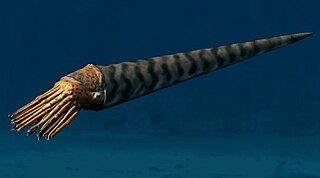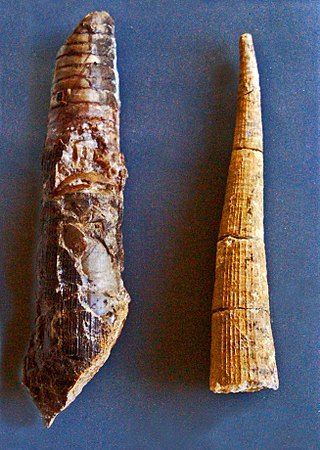
Orthoceratidae is an extinct family of actively mobile carnivorous cephalopods, subclass Nautiloidea, that lived in what would be North America, Europe, Asia, Africa, and Australia from the Ordovician through Triassic from 490—203.7 mya, existing for approximately 286.4 million years.
Discosorida are an order of cephalopods that lived from the beginning of the Middle Ordovician, through the Silurian, and into the Devonian. Discosorids are unique in the structure and formation of the siphuncle, the tube that runs through and connects the camerae (chambers) in cephalopods, which unlike those in other orders is zoned longitudinally along the segments rather than laterally. Siphuncle structure indicated that the Discosorida evolved directly from the Plectronoceratida rather than through the more developed Ellesmerocerida, as did the other orders. Finally and most diagnostic, discosorids developed a reinforcing, grommet-like structure in the septal opening of the siphuncle known as the bullette, formed by a thickening of the connecting ring as it draped around the folded back septal neck.

The Oncocerida comprise a diverse group of generally small nautiloid cephalopods known from the Middle Ordovician to the Mississippian, in which the connecting rings are thin and siphuncle segments are variably expanded. At present the order consists of some 16 families, a few of which, such as the Oncoceratidae, Brevicoceratidae, and Acleistoceratidae contain a fair number of genera each while others like the Trimeroceratidae and Archiacoceratidae are represented by only two or three.
Spyroceras is a genus of pseudorthocerids from the Devonian of North America and Europe, defined by Alpheus Hyatt in 1884. Pseudorthocerids are a kind of orthocertaoid, a taxonomic group within the Nautiloidea. Specifically Spyroceras belongs to the pseudorthocerid family, Spyroceratidae.
Turnoceras is a genus of Devonian cephalopods belonging to the oncocerid family Nothoceratidae. Its shell is broadly expanding and exogastrically curved such that the flattened dorsum is on longitudinally concave side. Aperture unconstricted with no hyponomic sinus for the water jet funnel. siphuncle along the outer, ventral, side, with radial, plate-like actinosiphonate deposits occupying the interior.
Jovellania is a genus of extinct prehistoric nautiloids from the order Oncocerida known from the Lower Devonian of Europe. Nautiloids form a broad group of shelled cephalopods that were once diverse and numerous but are now represented by only a handful of species in two genera.

Kionoceras is an extinct nautiloid cephalopod genus included in the orthocerid family Kionoceratidae with scattered worldwide distribution from the Middle Ordovician to the Lower Permian. Kionoceratids are orthocerids with prominent longitudinal ornamentation on their shells, sometimes augmented by secondary transverse ornamentation. Orthocerids are, of course, prehistoric nautiloides with generally straight and elongate shells, mostly with central or subcentral siphuncles.
Neocycloceras is an extinct genus of nautiloid included in the Pseudorthocerida that lived during the Late Devonian and Mississippian. Neoclycloceras is characterized by a slender, generally circular shell with slightly oblique, sinuous surficial annulations. Its sutures have dorsal and ventral saddles and lateral lobes and become more oblique with age. Saddles point forward, lobes to the rear. Dorsal saddles are broad and low but the ventral ones are high and conspicuous. The siphuncle is located between the center and venter and is nummuloidal, composed of rounded expanded segments, the inside of which contains a continuous laminar lining that is thickest in the middle of the segments and thinnest at the septal necks. Neocycloceras has been found in Pennsylvania in North America and in Morocco in north Africa.

Geisonoceratidae is an extinct family of orthoceroid cephalopods endemic to what would be Asia, Europe, and North America from the Middle Ordovician to the Middle Devonian living from about 470—380 mya, existing for approximately 90 million years. With the possible addition of an Early Cretaceous orthocerid from the western Caucasus the range of this group increases dramatically to some 350 million years, thus making it one of the longest lived families of the Nautiloidea.

Dawsonoceratidae is an extinct family of orthoconic nautiloid cephalopods that lived in what would be North America and Europe from the Late Ordovician through the Middle Devonian from about 480–390 mya, existing for approximately 90 million years.

Orthoceratoidea is a major subclass of nautiloid cephalopods. Members of this subclass usually have orthoconic (straight) to slightly cyrtoconic (curved) shells, and central to subcentral siphuncles which may bear internal deposits. Orthoceratoids are also characterized by dorsomyarian muscle scars, extensive cameral deposits, and calciosiphonate connecting rings with a porous and calcitic inner layer.

Kionoceratidae is a family in the Orthocerida, proposed by Hyatt in 1900 for genera characterized by prominent ornamentation in the form of longitudinal ribs, ridges, or lirae, or combinations thereof, sometimes with similar transverse ornament or faint transverse annulations.
Macroloxoceras is a large pseuorthocerid from the upper Devonian of Central Colorado and Southern New Mexico with features resembling those found in actinocerids. Pseudorthocerids and actinocerids are extinct nautiloid cephalopods, generally with long straight shells and expanded siphuncle segments filled with organic deposits.
Pseudactinoceraidae is a family in the cephalopod order Pseudorthocerida, known from the Upper Devonian and Lower Carboniferous (Mississippian).

Plagiostomoceras is an orthocerid cephalopod from the lower Paleozoic of Europe and Australia.
Trematoceras is an orthoconic nautiloid cephalopod from the Upper Triassic of Europe and Asia named by Eichwald in 1851.
Parakionoceras is an extinct nautiloid that lived during the Silurian and Devonian in what is now Europe; included in the orthoceratoid family Kionoceratidae in the Treatise part K, 1964 but removed to the Arionoceratidae in Kröger 2008.
Polygrammoceras is an orthoconic nautiloid that lived during the period from the middle Ordovician to the early Devonian in what is now North America and Eurasia.
Intejocerida is the name given to a group of generally straight shelled nautiloid cephalopods originally found in Lower and Middle Ordovician sediments in the Angara River basin in Russia; defined in the Treatise as an order, and combined there with the Endocerida in the Endoceratoidea.

Geisonoceras is an extinct orthocerid genus named by Hyatt, 1884, and type for the Geisonoceratidae established by Zhuravleva in 1959.







